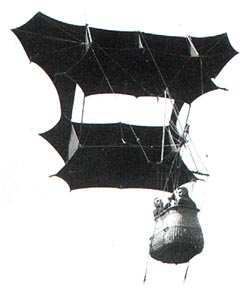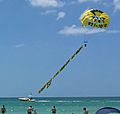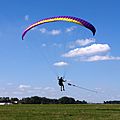Man-lifting kite facts for kids
A man-lifting kite is a special kind of kite that's strong enough to lift a person off the ground. Long ago, people mainly used these kites for looking around from high up, like a spy in the sky. This was called reconnaissance.
When airplanes were invented in the early 1900s, people stopped developing man-lifting kites as much. But later in the 20th century, these kites became popular again for fun and sports. Today, you often see them in exciting activities like kitesurfing, where people get lifted briefly from the water, and parasailing, where a kite pulls someone behind a boat or vehicle.
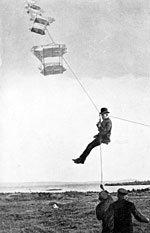
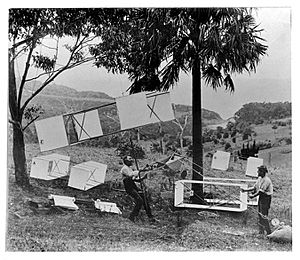
Contents
Early Man-Lifting Kites
In the 1820s, a British inventor named George Pocock created some of the first man-lifting kites. He even tested them with his own children!
Kites for Military Use
In the early 1890s, Captain B.F.S Baden-Powell developed a hexagonal (six-sided) kite called the "Levitor." He hoped the army could use it to lift soldiers for observation or to carry heavy things like radio antennas. In 1894, he successfully lifted a man 50 feet (15.25 meters) off the ground. By the end of that year, he was regularly lifting men over 100 feet (30.5 meters). His kites were sent to South Africa for the Second Boer War, but they arrived after the fighting ended.
Box Kites and Tetrahedral Kites
Lawrence Hargrave invented the box kite in 1885. He later connected four of these box kites together to create a system that could lift a person. On November 12, 1894, he lifted himself 16 feet (4.9 meters) from a beach in Stanwell Park, New South Wales. His body and the kite system together weighed 208 pounds (94.5 kg).
Alexander Graham Bell, famous for inventing the telephone, also worked on kites. He developed a tetrahedral kite, which looked like a honeycomb made of many small triangles. Bell and his team believed these kites would be lighter and lift better. They tested their kites over water to make it safer. In 1907, one of Bell's large tetrahedral kites, called "Cygnet III," was towed by a boat and carried a man 168 feet (51.2 meters) above the sea.
Cody's War Kites
Samuel Franklin Cody was one of the most successful pioneers of man-lifting kites. He improved on Hargrave's box kite design and patented his own in 1901. Cody believed his kites could be used by the military for observation. He even crossed the English Channel in a boat pulled by a kite!
Between 1904 and 1908, Cody conducted trials for the British military. He set a new record by lifting a passenger to a height of 1,600 feet (488 meters) on a 4,000-foot (1,219-meter) cable. In 1906, the military officially adopted Cody's War Kites for their Balloon Companies. These kites were used for observation on windy days when their large observation balloons couldn't fly. Cody's system used several kites in a line to lift the person. He also built a "glider kite" that could be launched like a kite but then released to fly back down like a glider.
Even Roald Amundsen, the famous polar explorer, tested a man-lifting kite for use in the Arctic. However, the tests were not successful, and he didn't use the idea.
Modern Kiting Sports
In the late 20th and early 21st centuries, new inventions made people interested in being lifted by kites for fun. The rise of water skiing especially led to the idea of adding a kite so skiers could fly.
From Flat Kites to Parafoils
Starting in the late 1950s, flat kites were used to pull skiers. Other kites had seats attached to the line and were pulled by motorboats. Skiers could control these early kites a little by shifting their body weight on swing seats.
In the 1960s, the Rogallo wing was developed. Many early designs, like those by Australian inventors John Dickenson and Bill Bennett, were made into manned kites. John Dickenson is even called the inventor of the modern hang glider because of his designs for man-lifting kites and gliders.
The invention of the parafoil kite in 1964 was a big step forward for water sports. Parafoil sails provide a lot of lift and can be controlled with multiple lines, making them easier to steer. By the 1970s, parachute-powered water skiing became a popular sport around the world. Over the next 20 years, parafoils became more common, and single-line lift systems were replaced with steerable multi-line setups.
Images for kids


